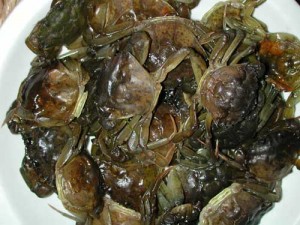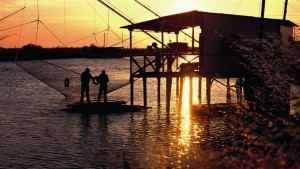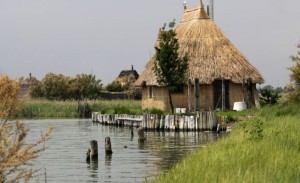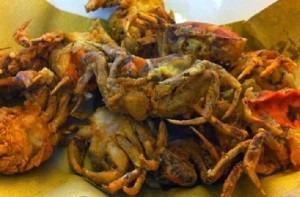Le MoecheThe “Moeche” (moulting crabs)
Arrivano le moeche! Ma vediamo cosa sono e come vengono pescate e cucinate!
Come ogni anno, in autunno e a primavera arrivano le moeche in Laguna a Venezia e come ogni anno, per qualche settimana, sono il piatto più richiesto perchè le moeche oltre ad essere buonissime suscitano la curiosità di turisti e passanti che si domandano: ma cosa sono le moeche?
Ecco vogliamo rispondere a questa domanda!
Chiariamo prima che le moeche sono dei crostracei e nella fattispecie dei granchi.

Quando si parla di “arrivo delle moeche”, non si intende una vera migrazione o l’ arrivo dei dei granchi in Laguna. I granchi infatti si pescano tutto l’anno e inoltre non sono certo dei crostacei migratori però compiono una serie di “mute” e ciclicamente abbandonano il “vestito vecchio” per adeguarsi al cambiare della stagione.
Per “arrivo delle moeche” si intende il momento dell’anno che cade all’inizio dell’autunno o della primavera, in cui i granchi, si spogliano del carapace per adattarsi alla stagione in arrivo.
Ecco le moeche non sono altro che i granchi nello spazio temporale in cui, abbandonata la vecchia corazza, non hanno ancora rigenerato il nuovo carapace. Lo spazio di poche ore dalla perdita della muta all’avvio del ciclo biologico per cui il carapace viene rigenerato, fa di un granchio una moeca.
Ecco perchè si chiamano moeche
Spogliati della corazza i granchi sono molto teneri e quasi molli. E’ da questa loro consistenza tenera e molle che i veneziani hanno affibbiato ai granchi senza corazza il nome di moeche.
C’è però chi sostiene un’altra teoria più romantica che accosta le moeche al simbolo della città, il leone di San Marco. Pare infatti che le moeche per la loro rarità siano considerate delle pepite del mare tipiche di Venezia e che il nome moeca derivi da quello che è il simbolo di Venezia per eccellenza: il leone di San Marco. Il leone di San Marco viene raffigurato infatti con le ali proprio perchè sorge dalle acque e in dialetto locale detto el leon en moéca. Come il leone alato, sono preziosi i prodotti del mare che dal simbolo cittadino prendono il loro nome.

La pesca delle moeche è l’arte dei moecanti
La tradizione delle moeche è presente in tutta la Laguna e in particolare nelle zone di Chioggia, Giudecca e Burano. I pescatori di Laguna detti moécanti, utilizzano per la pesca il metodo tradizionale con delle reti di posta che garantiscono la salvaguardia del sistema biologico marino.
Una volta pescate, le moéche vengono trasferite in appositi sacchi di juta che hanno lo scopo di mantenere la giusta umidità durante il trasporto agli impianti di lavorazione. A questo punto, nei casòni o casòti
si avvia la fase di cernita che ha la funzione di individuare lo stato biologico dei granchi. In questa fase, i moecanti, grandi conoscitori di questi crostacei, selezionano i granchi dividendo quelli maturi (carapace già cambiato) da quelli prossimi alla muta. Solo i granchietti prossimi alla muta saranno sistemati in apposite casse di legno dette vièri e semisommersi in acqua marina per diventare in breve tempo moeche.
Moeche in cucina
Le moeche sono apprezzatissime in cucina specialmente se cucinate fritte. Essendo un prodotto di una prelibatezza inconsueta e reperibile solo per qualche settimana l’anno, sono considerate un cibo assolutamente raro e ricercato.
Like every year, in autumn and spring the moeche coming in Laguna in Venice and like every year, for a few weeks, they are the most popular dish because moeche besides being delicious arouse the curiosity of tourists and passers-by who wonder: what are moeche?
Here we want to answer this question!
Clarify before the moeche are shellfish and in this case crabs.

When we speak of “arrival of moeche”, it does not mean a real migration or the ‘arrival of the crabs in Laguna. The crabs are caught it all year and also are not certain migratory shellfish but perform a number of “moulting” and cyclically abandon the “old garment” to adjust to the change of the season.For “arrival of moeche” it means the time of year that falls in early autumn or spring, when the crabs, they strip the shell to fit the coming season.
Here are the moeche are nothing more than crabs in the space of time in which, abandoned the old shell, have not yet regenerated the new carapace. The space of a few hours by the loss of the moulting at the start of the biological cycle to which the shell is regenerated, does a crab a moeca.
That’s why they call moeche
Stripped of the shell crabs are very tender and almost soft. And ‘from this their tender texture and soft that Venetians have saddled the crabs without armor name moeche.
But there is who supports another theory, most romantic, that combines the moeche to the city’s symbol, the lion of St. Mark. It appears that the moeche for their rarity are considered sea nuggets typical of Venice and that the name moeca derives from what is the symbol of Venice par excellence: the lion of St. Mark. The lion of St. Mark is depicted with wings just because it rises from the water and in the local dialect is called “el leon en moeca”. Like the winged lion, they are valuable sea products that from the symbol of the city are named.

Fishing for moeche is the art of the moecanti.
The tradition of moeche is present throughout the Laguna and in particular in the areas of Chioggia, Burano and Giudecca. The fishermen of Laguna called moécanti, use for fishing the traditional method with sèecial nets that ensure the protection of marine biological system. Once harvested, the moeche are transferred in suitable jute sacks which have the purpose of keeping the right moisture during transportation to processing plants. At this point, in “casoni” or “casòti”
starts the sorting phase which has the function of identifying the biological state of the crab. At this stage, the moecanti, great connoisseurs of these crustaceans, select crabs by dividing mature ones (carapace already changed) from those closer to the moulting. Only the crabs coming to the moulting will be placed in special wooden boxes called vieri and half-submerged in sea water to become in a short time moeche.
Moeche in the kitchen
Moeche are highly appreciated in the kitchen, especially if you cook fried. Being a product of an unusual delicacy and available only for a few weeks a year, they are considered a food absolutely rare and sought after.







Leave a comment